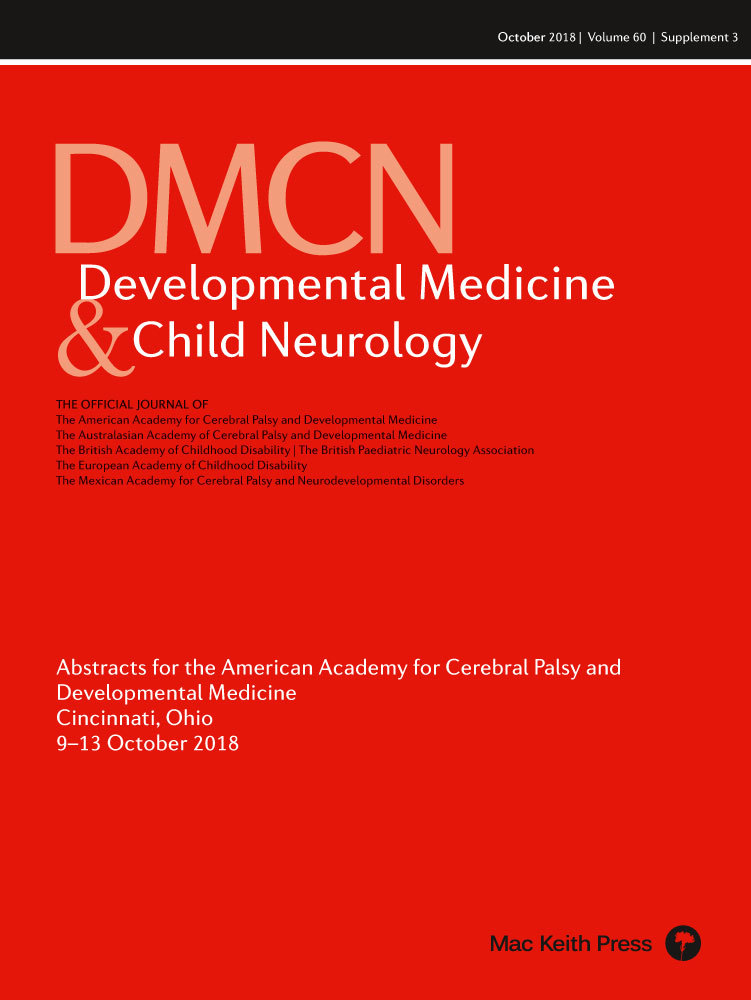The relationship between bimanual performance, MRI lesion type and cognition in unilateral cerebral palsy
K10
A Crichton1, B Hoare2, M Ditchfield3, M Thorley4, M Wallen5, J Bracken6, A Harvey7, I Novak8, C Elliott9, SM Gwini10
1Monash Children's Hospital; 2Monash Children's Hospital, Senior Research Fellow - La Trobe University, Honorary Research Fellow - Monash University and Australian Catholic University; 3Monash Children's Hospital; 4Queensland Paediatric Rehabilitation Service; 5School of Allied Health - Australian Catholic University, Honorary Research Fellow - Cerebral Palsy Alliance, The University of Sydney; 6Royal Children's Hospital; 7Murdoch Children's Research Institute; 8Cerebral Palsy Alliance, The University of Sydney; 9Curtin University; 10School of Public Health & Preventive Medicine, Department of Epidemiology, Monash University, Clayton, University Hospital Geelong, Barwon Health, Geelong
Background and Objective(s): Research suggests that specific cognitive functions may be associated with bimanual task performance in children with unilateral cerebral palsy (CP), yet it is unclear whether this is influenced by the neuropathological heterogeneity of this clinical population. We examined whether neuropathology (magnetic resonance imaging (MRI) abnormality classification), and other clinical characteristics mediate the relationship between executive function (EF) and bimanual performance in children with unilateral CP.
Study Design: Prospective, cross-sectional multi-centre observational study.
Study Participants & Setting: The sample comprised 64 children, including 39 males (61%), aged 6–12 years at recruitment (mean age 9.0y; SD 1.9y), recruited from five Australian paediatric treatment centres between July 2012 and August 2015, with unilateral CP (53% right hemiparesis; CS I (n=16), CS II (n=47), CS III (n=1)).
Materials/Methods: The Assisting Hand Assessment (AHA), a standardized, criterion-referenced test of bimanual performance was the primary outcome. MRI were coded using an established protocol and data extracted retrospectively from clinical MRI scans, coded as normal or any of the five predominant pathological patterns: White Matter Injury (WMI), Grey Matter Injury (GMI), Focal Vascular Injury (FVI), malformations and miscellaneous pathologies. Parents completed a global EF questionnaire, and children completed standardised tests of EF (information processing, attention control, cognitive flexibility and goal setting) and intellectual function. The relationship between bimanual performance and the four EF domains, general executive functioning and MRI pathology type were examined using linear regression models
Results: Comparisons were between WMI and FVI pathologies. No children had GMI. There were few children with mixed pathologies on MRI (n=3), normal MRI scans (n=2), malformations (n=4) and miscellaneous lesions (n=1); these were excluded from the analyses. The general executive composite demonstrated a significant interaction with MRI abnormality type (p=0.04). The estimated effect of the relationship between general EF and AHA was 0.75 points lower in the FVI group compared with the WMI group. However, when clinical characteristics were included in the model, this interaction did not remain independently significant. There were no significant interactions between each of the four executive domains and MRI abnormality.
Conclusions/Significance: With the aim of elucidating brain-behaviour and function relationships, we explored the impact of MRI lesion patterns on the relationship between cognitive and bimanual task performance in children with unilateral CP. However, our data did not support any influence by MRI abnormality type on the relationship between cognitive function and bimanual performance.




